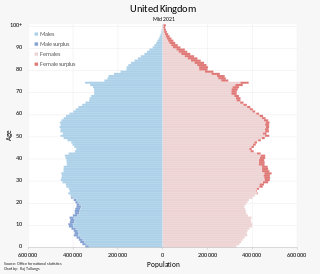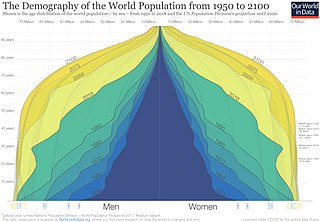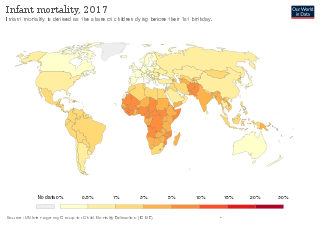Related Research Articles

This is a demography of the population of Cambodia including population density, ethnicity, education level, health of the populace, economic status, religious affiliations and other aspects of the population.

India is the second most populated country in the world with a sixth of the world's population. According to official estimates, India's population stood at 1.38 billion.

The demographics of China demonstrate a huge population with a relatively small youth component, partially a result of China's one-child policy. China's population reached 1 billion in late 1981.

The population of the United Kingdom was estimated at over 67.0 million in 2020. It is the 21st most populated country in the world and has a population density of 270 people per square kilometre, with England having significantly greater density than Wales, Scotland, and Northern Ireland. Almost a third of the population lives in South East England, which is predominantly urban and suburban, with about 9 million in the capital city, London, whose population density is just over 5,200 per square kilometre.

Demography is the statistical study of populations, especially human beings.

The United States had an official estimated resident population of 331,893,745 on July 1, 2021, according to the U.S. Census Bureau. This figure includes the 50 states and the District of Columbia but excludes the population of five unincorporated U.S. territories as well as several minor island possessions. The United States is the third most populous country in the world. The Census Bureau showed a population increase of 0.12% for the twelve-month period ending in July 2021, below the world average annual rate of 0.9%. The total fertility rate in the United States estimated for 2021 is 1.664 children per woman, which is below the replacement fertility rate of approximately 2.1.

Infant mortality is the death of young children under the age of 1. This death toll is measured by the infant mortality rate (IMR), which is the probability of deaths of children under one year of age per 1000 live births. The under-five mortality rate, which is referred to as the child mortality rate, is also an important statistic, considering the infant mortality rate focuses only on children under one year of age.

Mortality rate, or death rate, is a measure of the number of deaths in a particular population, scaled to the size of that population, per unit of time. Mortality rate is typically expressed in units of deaths per 1,000 individuals per year; thus, a mortality rate of 9.5 in a population of 1,000 would mean 9.5 deaths per year in that entire population, or 0.95% out of the total. It is distinct from "morbidity", which is either the prevalence or incidence of a disease, and also from the incidence rate.

Estimates of the casualties from the Iraq War have come in several forms, and those estimates of different types of Iraq War casualties vary greatly.

The Lancet, one of the oldest scientific medical journals in the world, published two peer-reviewed studies on the effect of the 2003 invasion of Iraq and subsequent occupation on the Iraqi mortality rate. The first was published in 2004; the second in 2006. The studies estimate the number of excess deaths caused by the occupation, both direct and indirect.

India's population in 2021 as per World Bank is 1.39 billion. Being the world's second-most-populous country and one of its fastest-growing economies, India experiences both challenges and opportunities in context of public health. India is a hub for pharmaceutical and biotechnology industries; world-class scientists, clinical trials and hospitals yet country faces daunting public health challenges like child undernutrition, high rates of neonatal and maternal mortality, growth in noncommunicable diseases, high rates of road traffic accidents and other health related issues.
The Multiple Indicator Cluster Surveys (MICS) are household surveys implemented by countries under the programme developed by the United Nations Children's Fund to provide internationally comparable, statistically rigorous data on the situation of children and women. The first round of surveys (MICS1) was carried out in over 60 countries in mainly 1995 and 1996 in response to the World Summit for Children and measurement of the mid-decade progress. A second round (MICS2) in 2000 increased the depth of the survey, allowing monitoring of a larger number of globally agreed indicators. A third round (MICS3) started in 2006 and aimed at producing data measuring progress also toward the Millennium Development Goals (MDGs), A World Fit for Children, and other major relevant international commitments. The fourth round, launched in 2009, aimed at most data collection conducted in 2010, but in reality most MICS4s were implemented in 2011 and even into 2012 and 2013. This represented a scale-up of frequency of MICS from UNICEF, now offering the survey programme on a three-year cycle. The fifth round, launched in 2012, was aimed at offering countries the tools to do the final MDG data collection.
On January 9, 2008 the World Health Organization reported the results of the "Iraq Family Health Survey" published in the New England Journal of Medicine. The study surveyed 9,345 households across Iraq and was carried out in 2006 and 2007. It estimated 151,000 deaths due to violence from March 2003 through June 2006.
Health in the United Kingdom refers to the overall health of the population of the United Kingdom. This includes overall trends such as life expectancy and mortality rates, mental health of the population and the suicide rate, smoking rates, alcohol consumption, prevalence of diseases within the population and obesity in the United Kingdom. Three of these, smoking rates, alcohol consumption and obesity are above the OECD average.
The current population of Myanmar is 54.05 million. It was 27.27 million in 1970. The general state of healthcare in Myanmar is poor. The military government of 1962-2011 spent anywhere from 0.5% to 3% of the country's GDP on healthcare. Healthcare in Myanmar is consistently ranked among the lowest in the world. In 2015, in congruence with a new democratic government, a series of healthcare reforms were enacted. In 2017, the reformed government spent 5.2% of GDP on healthcare expenditures. Health indicators have begun to improve as spending continues to increase. Patients continue to pay the majority of healthcare costs out of pocket. Although, out of pocket costs were reduced from 85% to 62% from 2014 to 2015. They continue to drop annually. The global average of healthcare costs paid out of pocket is 32%. Both public and private hospitals are understaffed due to a national shortage of doctors and nurses. Public hospitals lack many of the basic facilities and equipment. WHO consistently ranks Myanmar among the worst nations in healthcare.
The National Child Development Study (NCDS) is a continuing, multi-disciplinary longitudinal study which follows the lives of 17,415 people born in England, Scotland and Wales from 17,205 women during the week of 3–9 March 1958. The results from this study helped reduce infant mortality and were instrumental in improving maternity services in the UK.
A new measure of expected human capital calculated for 195 countries from 1990 to 2016 and defined for each birth cohort as the expected years lived from age 20 to 64 years and adjusted for educational attainment, learning or education quality, and functional health status was published by The Lancet in September 2018. Latvia had the twenty-first highest level of expected human capital with 23 health, education, and learning-adjusted expected years lived between age 20 and 64 years.
The National Vital Statistics System (NVSS) is an inter-governmental system of sharing data on the vital statistics of the population of the United States. It involves coordination between the different state health departments of the US states and the National Center for Health Statistics, a division of the Centers for Disease Control and Prevention.

Maternal mortality refers to the death of a woman during her pregnancy or up to a year after her pregnancy has terminated; this metric only includes causes related to the pregnancy, and does not include accidental causes. Some sources will define maternal mortality as the death of a woman up to 42 days after the pregnancy has ended, instead of one year. In 1986, the CDC began tracking pregnancy related deaths to gather information and determine what was causing these deaths by creating the Pregnancy-Related Mortality Surveillance System. Although the United States was spending more on healthcare than any other country in the world, more than two women died during childbirth every day, making maternal mortality in the United States the highest when compared to 49 other countries in the developed world. The CDC reported an increase in the maternal mortality ratio in the United States from 18.8 deaths per 100,000 births to 23.8 deaths per 100,000 births between 2000 and 2014, a 26.6% increase. As of 2018, the US had an estimated 17.4 deaths per 100,000 live births. According to the CDC a study that included data from 36 states found that more than 80% of pregnancy related deaths were preventable between 2017-2019.
References
- ↑ "National Mortality Followback Survey Series". Inter-university Consortium for Political and Social Research. Retrieved 18 March 2016.
- ↑ "National Mortality Followback Survey". CDC. 2 June 2009. Retrieved 18 March 2016.